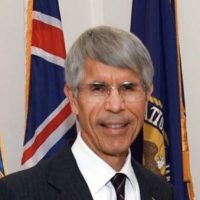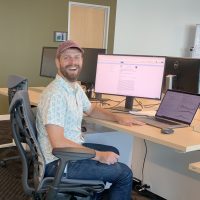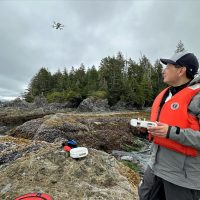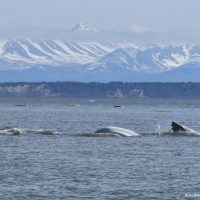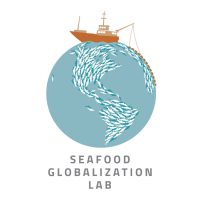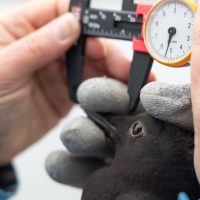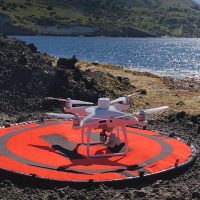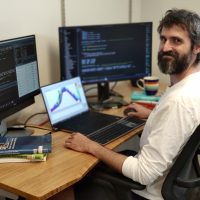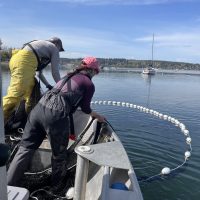Filter Results
Building community in meaningful ways: a talk with new Associate Director, Chelsea Wood
Settling into her new role as Associate Director and Graduate Program Coordinator of SAFS, Chelsea Wood is excited to help SAFS scale up its efforts to build community. “Learning and growth happen when people feel a sense of belonging, and that can be fostered by embedding them in a strong community,” she says. “Strong academic communities are tightly networked, with many and robust connections between individual people and across lab groups.
Read moreIn memoriam: Mike Tillman, SAFS alum
He obtained a Ph.D. in Fisheries Science from the University of Washington in 1972, and his research focused on marine mammal biology.
Read morePredator-prey relationships in Alaska fisheries management
In the world of fisheries management systems, many do not account for predator-prey interactions that scientists know can have big impacts on the dynamics and available biomass of commercially targeted species.
For his dissertation work as part of the Gulf Of Alaska Climate Integrated Modeling Project (GOA-CLIM), Grant Adams from the Punt Lab at SAFS, has been developing multi-species population dynamics models for the Gulf of Alaska.
Enhancing diversity, conducting drone research: welcome to Corey Garza
Welcoming the newest SAFS Professor and Associate Dean for Diversity, Equity and Inclusion for the College of the Environment, we spoke with Corey Garza. He shares his plans to enhance College diversity, what he’s most excited about by joining SAFS, and insight into his world of research using drones.
What plans do you have for Diversity, Equity and Inclusion (DEI) as Associate Dean?
Cataloging the canaries of the sea: studying vocal behavior, kinship and microbial transfer in Cook Inlet beluga whales
Known as the canaries of the sea for their highly vocal nature, beluga whales are found across the Arctic and sub-Arctic. There are 21 beluga populations worldwide, with five populations found in Alaska. Of these, the Cook Inlet beluga population is the most endangered, with current estimates hovering around the 300 mark. A highly diverged population, the Cook Inlet belugas are geographically and genetically isolated, remaining in Cook Inlet year-round.
Read moreNew job opening for aquatic food system data scientist
Position now closed
A new position is opening for an Aquatic Food System Data Scientist in incoming Professor Jessica Gephart’s lab.
The Aquatic Food System Data Scientist will join an interdisciplinary team focused on aquatic food production and trade. Aquatic food plays an important role in global food security, providing nearly 20% of global animal protein and supplying essential fatty acids and micronutrients.
“Someday I’ll fly away”: monitoring hatchling to fledgling timescales on Protection Island
Nesting season on Protection Island is a busy time for SAFS Masters student, Liam Pendleton. Home to tens of thousands of pigeon guillemots and rhinoceros auklets, Liam travels to Protection Island in the Strait of Juan de Fuca every week from May to September to conduct research and monitoring of these seabirds.
Working in the Quantitative Conservation Lab, led by Sarah Converse, Liam is studying the link between breeding success, and marine environmental conditions.
Apply to be a postdoctoral scholar to conduct coastal drone research at SAFS
Dr. Corey Garza’s lab at the University of Washington (the Marine Landscape Ecology Lab), seeks to hire a Postdoctoral Scholar in the School of Aquatic and Fishery Sciences (SAFS). The position is supported by internal funding from the School of Aquatic and Fishery Sciences. The candidate hired into this position will have the opportunity to engage in research that utilizes aerial drones to map coastal habitats ranging from the rocky intertidal to kelp forests and statistical modeling to understand the drivers of spatial variation in coastal habitats.
Read moreEcosystem modeling of the Gulf of Alaska for fisheries management
In a post-doc focused on modeling climate change effects in the Gulf of Alaska (GOA), Alberto Rovellini is part of the Punt Lab at SAFS. Beginning in 2020, Alberto’s work is on this area of Alaska which is facing big implications as a result of climate change, from negative economic implications for important fisheries to adverse ecological impacts on plankton, fish, mammals, and seabirds.
Read moreNear or far: how is fish abundance affected by shoreline armoring?
Conducting fieldwork as part of a project funded by Washington Sea Grant, Emily Bishop, a masters student in the Marine Conservation and Ecology Group at SAFS, is exploring the effects of shoreline armoring on nearshore fish abundance.
Shoreline armoring is the term for structures that landowners install on their beaches to prevent erosion and preserve property extent. These structures change the physical characteristics of the beach, potentially making the habitat lower quality for fish that use shallow water to avoid predators, or to feed on terrestrial insects.

